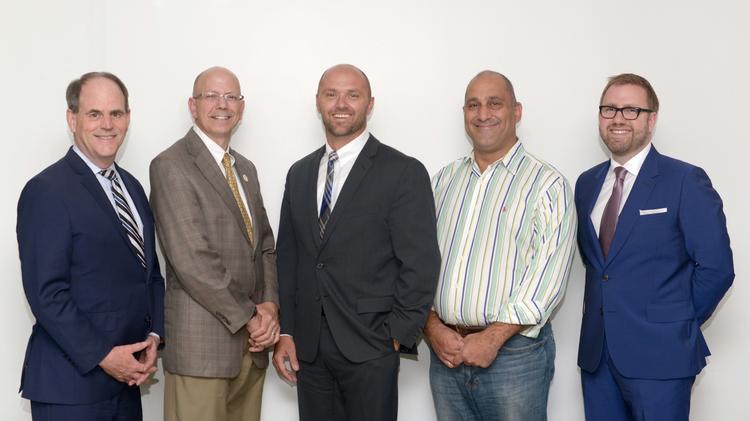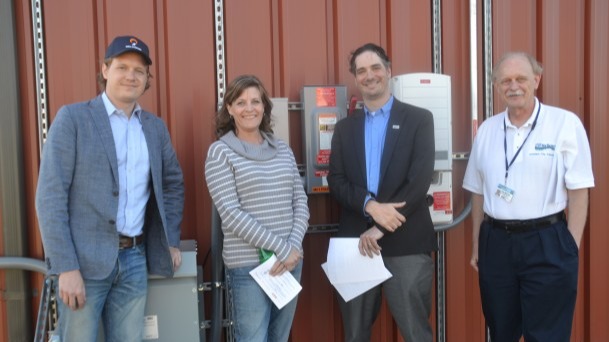Table of Experts: Energy
The Minneapolis-St. Paul Business Journal held a panel discussion recently on the topic of energy. Panel members included Andrew Moratzka, energy regulatory partner at Stoel Rives; Brent Wavra, president and director of business development at CxS Connect; Chris Psihos, president and CEO of iDEAL Energies; and Jim Berge, business development representative at King Solutions. Michael Noble, executive director of Fresh Energy, served as moderator.

From left: Michael Noble, Fresh Energy; Jim Berge, King Solutions; Brent Wavra, CxS Connect; Chris Psihos, iDEAL Energies; Andrew Moratzka, Stoel Rives
EXCERPT:
Noble: In the past five years, solar has really taken off. In 2012 or 2013 there might have been $50 million in solar in Minnesota, and now we have a billion-dollar industry, one of the hottest industries in Minnesota. Chris, how is this climate of innovation and momentum affecting your business prospects?
Psihos: We’ve incurred immense growth. A lot of it has to do with the development of solar panels that are very economical; the cost has come down nearly threefold since 2010. So we can now deliver solar assets at values that we were just not able to, historically. So with the cost coming down and some of the incentives in place at the federal and state level, we’re able to deliver assets to our customers that offset part of their electrical consumption, which offsets the production of greenhouse gases. The world and economy of solar have completely changed, allowing us to provide solar projects to our customers that are coupled with an immediate return on investment. The costs of coal plants and solar have reached grid parity, which means that solar can be built and delivered at the same cost as fossil fuels, which is remarkable.
Noble: That’s true. The data are out there. Sooner or later the crossover will be everywhere, and solar will be cheaper than the incumbent fuels.
Psihos: Right, so we’re continually developing the market so we can get ahead of that parity point. But we’ve got to be really careful and work with the utilities, to make sure it’s overlaid on their infrastructure in a way that works for all parties.
Noble: Who is your typical customer, and what is their motivation? Why do they come to you?
Psihos: Our typical customers are for-profit businesses, nonprofit businesses and the public sector who want to go green and reduce their energy expense. People want to go green, but they want to make sure they have price parity. It’s challenging to get people to make decisions just because they’re green, but if they have a choice between green and nongreen and the cost is equal or they can even save a few dollars, it really changes the dynamic. The economics allow them to make green decisions that they were never able to before.
Noble: For the CEO of a business, maybe with 200 employees and their own facility, what does a solar deal look like financially?
Psihos: They would put a solar array on their building or property, and the energy produced reduces the energy they have to consume from the grid. It’s like putting in LED light bulbs — they’re reducing the quantity of energy they have to consume from the utility. The transaction is about how the energy produced from the solar array creates a reduction in expense over time, and based on assumptions about the cost of energy in the future, we develop financial models that provide real-time solutions to customers. We try to have a net positive purchase, meaning that they’re going to save money at every point, and then when the asset is paid off, they’re getting energy for free for the life of the asset.
Wavra: We’re on the front end of designing the building for our customer, and solar came up. So how can we get you in front of our clients as we’re designing their building?
Psihos: The first step is understanding how a solar project is developed. When solar assets are placed on a building, you need to understand the structural impacts (ballasted rooftop systems add approximately four to five pounds per square foot of additional load) and make sure your building can accommodate them. Existing buildings usually can, and new buildings can for sure because they can be designed from the onset to accommodate the additional load. If you cannot accommodate the additional load, you can’t put solar on your building safely and in compliance with building and mechanical code.
Wavra: Is that something we could ask of you? We have a client, a church, who may want a solar array; can we come to you to get the life cycle, financial package and cost calculation?
Psihos: Yes! That’s what we do as a company. We sit down and look at your consumption, try to find the right incentives and products, and make the transaction work economically.
Noble: So if you have a customer who wants solar, how do you help him make his building more energy efficient?
Psihos: So this is where it’s fun. Brent is in the business of measuring data points inside a building: total energy consumption, or kilowatt-hours, and instantaneous consumption, or demand, which is measured in kilowatts. Every 15 minutes, the utility measures a point at which the maximum instantaneous demand occurs. So if I turn on all my motors at once, I’m going to suck a lot of energy from the grid, and they’re going to bill me based on that instantaneous amount I consume, even if I never do that again in that month. So by knowing when maximum demand occurs in a building, and when the energy produced from a solar array is produced, by lining up the foregoing, we can capture a reduction in demand. That’s what the utility wants, is for us to shave demand from the grid at the peak times when the grid needs it.
Wavra: It’s what we call peak shaving in our industry.
Noble: Where do you see the growth coming in the solar industry over the next five years?
Psihos: You’re asking that at a time of massive change in Minnesota, at least in the commercial market. We’ve replaced incentive programs that were instrumental in developing markets with different programs, rules and incentives. That’s going to create a bit of a strangulation of the small commercial market, because it’s going to be harder to deliver projects. The small commercial market is beholden to incentives that bridge the gap, because certain costs of huge or small projects won’t go away. If I have to normalize those same costs across a small project, it becomes very challenging. The opportunity is in the larger rooftop market. There’s some work at the Public Utilities Commission right now that will be instrumental in developing a middle market of commercial solar — from 100 kilowatts to a megawatt in the near future.
Berge: So is it building size or kilowatt-hours? What’s the break-even point for a company that wants to put solar in?
Psihos: For a for-profit transaction, you’re looking at a return on investment, depending on the parameters, approximately between six and 10 years. For a nonprofit or the public sector, you have to introduce different types of business models in order to leverage federal tax incentives that they cannot use directly. Either way, our programs are designed to provide immediate and long-term savings for our customers day one that grow exponentially over time.
Noble: You hear people say, “Minnesota? Is it sunny enough there for solar?”
Psihos: We have about 200 sunny days a year here, and we’re cool, and solar performs better in cooler conditions. So we actually have one of the best solar climates in the country. I think having a billion-dollar industry, with another billion coming in as you described, are clear testament to that.
For the full article and transcripts, check out the article here at Bizjournals.com/twincities
DOWNLOADABLE PDF HERE: Table of Experts_Energy

For the full article and transcripts, check out the article here at Bizjournals.com/twincities
Share this
You May Also Like
These Related Stories

Solar for Schools: White Bear Lake Area Schools "Flip the Switch"

MN Solar Goes Big with Changes to Incentive Programs



No Comments Yet
Let us know what you think